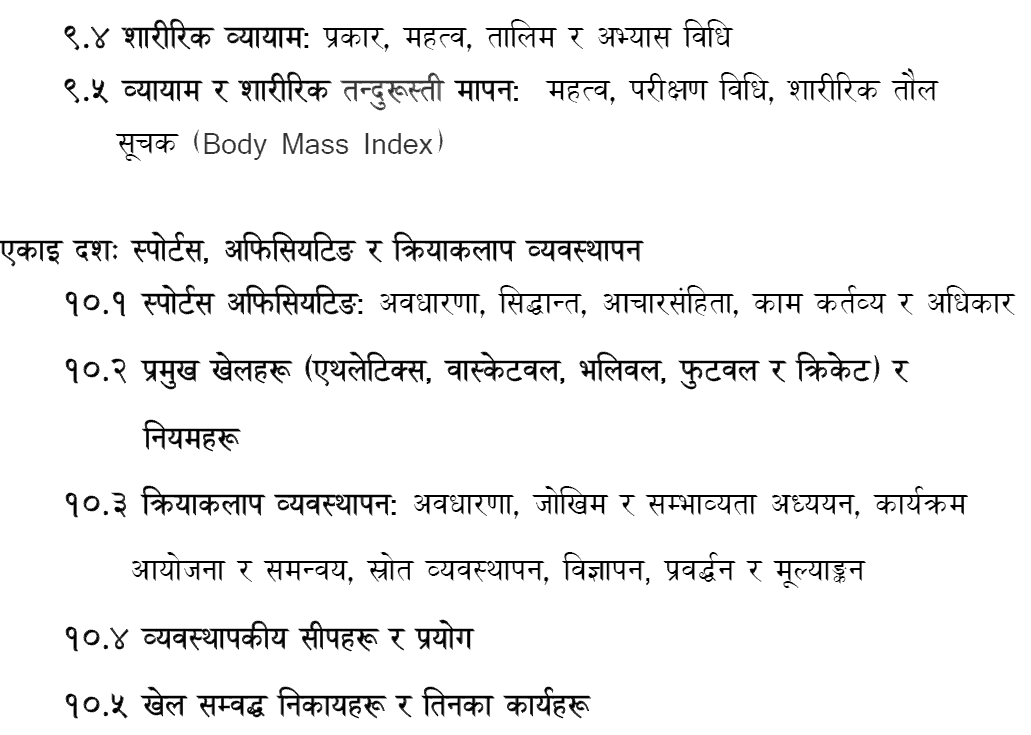
Health and Physical Education - curriculum of Secondary Level - TSC
Government of Nepal, Teacher Service Commission
The curriculum of Secondary Level Open Competitive Thematic Examination-2076
Subject: Health and Physical Education
Full Marks: 100
Time: Hours
Section: A
Unit One: Health Education Teaching
1.1 Health education: Concept, importance, purpose and practical application
1.2 Health education and healthy living: interrelationships, health education program operation strategies, assessment of the health lives of individuals and communities
1.3 Mental Health: Introduction and Characteristics, Types, Mental Health Related Problems (Including Drug Addiction), Prevention and Situation in Nepal
1.4 Health and Hygiene: Needs and Importance, Promotion of Personal and Environmental Hygiene, School Health and Hygiene
1.5 The Philosophical Basis of Health Education and Health Education Teaching in the Context of Nepal
Unit Two: Teaching the Human Body and Life Process
2.1 Human body: Introduction, importance, composition, body parts, and functions
2.2 Life Process: Concept and Importance, Human Body System, Anatomy and Physiology
2.3 Human Life Development: From Pregnancy to Death
2.4 Sexual and Reproductive Health: Sexual and Sexuality, Ingredients of Reproductive Health and Reproductive Rights
2.5 The interrelationship between heredity, environment and human life
Unit Three: Physical Education Teaching
3.1 Physical education: introduction, purpose, importance, and functions
3.2 Basics of physical education: biological, psychological, social and philosophical
3.3 Development of physical education
3.4 Sports Psychology: Introduction, Significance, Types, and Areas, Excitement and Motivation
3.5 Physical education, sports studies, and management
Unit Four: Sports Medicine, Yoga and Lifestyle Teaching
4.1 Sports Medicine: Introduction, Importance, and Features
4.2 Doping test: importance, need and current status
4.3 Injuries: Causes and Prevention Measures
4.4 Sports and nutrition: interrelationships, balanced diet, nutritious food and resources
4.5 Yoga and Life Style: Introduction, Yoga, Rules of Yoga and Yoga Practice
Unit Five: Secondary Level Health and Physical Education Curriculum Study
5.1. Curriculum and textbooks: Curriculum, textbooks, and teachers for grades 9-10 Directory study and interrelationships
5.2. Health and Physical Education Teaching: Teaching Methods, Teaching Plans and Strategies
5.3. Teaching Materials: Collection, development, and use of teaching materials and supplementary materials
5.4. Examinations and Assessments: Examinations and Assessments in Health and Physical Education Teaching,
Specification schedule and experiment, continuous student assessment system
5.5. Student Physical Fitness Test (2/1/5089. 1754 165110): Methods and Uses
Section B
Unit Six: Disease and Nutrition
6.1 Health and disease determinants: biological, socio-cultural and physical
6.2 Infectious Diseases: Causes, Symptoms and Prevention Food and water transmission (diarrhea, measles, and mumps), insect transmission (malaria, kala-azar, and Japanese encephalitis), airborne transmission (cold, pneumonia, measles and tuberculosis), sexually transmitted infections ( Hepatitis A and V, Hepatitis A and V, Hepatitis B and Virus Bird Flu, Swine Flu and Coronavirus (Covid-19).
6.3 Non-communicable diseases: types, symptoms, and prevention measures (heart attack, blood pressure, cancer, diabetes, asthma, and gallstones, etc.),
6.4 Nutrition: Concept, source, type, function, and balanced diet
6.5 Nutritional Deficiency Diseases: Symptoms and Prevention Measures
Unit Seven: School Health Program
7.1 Health Awareness Program
7.2 Multiple school health and safety programs
7.3 School Clean Drinking Water and Sanitation Program
7.4 School Emergency Health Services
7.5 Policy and legal provisions related to health and environment
Unit 8: Health care and first aid
8.1 First aid: introduction, need, importance and methods
8.2 Health protection: needs, importance, and methods
8.3 Emergency Health Management: Accidental health problems (spasms, drowning, bleeding, fractures, cuts, bites, etc.) and their management
8.4 Sanitation: Home, Family and Environmental Sanitation (Concept, Barriers, and Management), School Sanitation Program
8.5 School health and safety-related organizations: Red Cross, children's club, community health post, hospital, etc.
Unit 9: Physical Exercise and Kawaj
9.1 Physical training, parade, and command
9.2 School level. National and International Games: Presidential Running Shield Competition, National Competitions, South Asian Games, Olympic Games, World Cup Games
9.3 Children with special needs and sports: Sports and physical activities among children with disabilities
9.4 Physical Exercise: Types, Importance, Training and Exercise Method
9.5 Exercise and Physical Fitness Measurement: Significance, Test Method, Body Weight Indicator (Body Mass Index)
Unit Ten: Sports, Offsetting and Activity Management
10.1 Sports Offsetting: Concepts, Principles, Code of Conduct, Duties, and Rights
10.2 Major Sports (Athletics, Basketball, Volleyball, Football, and Cricket) and Rules
10.3 Activity Management: Concept, Risk and Feasibility Study, Program Planning and Coordination, Resource Management, Advertising, Promotion, and Evaluation
10.4 Managerial skills and usage
10.5 Sports-related bodies and their functions
Specification Table:
Subject: Health and Physical Education
Level: Secondary
Total Question: 10
Total Marks: 100
Each Question: 10 Marks
Section - A
1. Health Education Teaching
2. Teaching the Human Body and Life Process
3. Physical Education Teaching
4. Sports Medicine, Yoga and Lifestyle Teaching
5. A secondary level health and physical education curriculum study 1 10
Section - B
6. Diseases and nutrition
7. School Health Program
8. Health care and first aid
9. And school health program physical exercise and exercise
10. Sports, Offsetting and Activity Management
Note:
1. The curriculum is divided into two sections, section A and section B.
2. Generally, the questions asked from section A will be related to the teaching method.
3. The questions to be asked from section 3 B will be of the cognitive level.
4. A separate answer sheet will be used for each section.
5. The medium of written examination will be in Nepali or English or both languages.
6. This course 2077. 02. It will be implemented from the 25th of this month.









